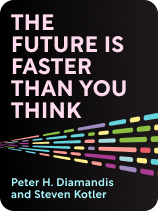

This article is an excerpt from the Shortform book guide to "The Future Is Faster Than You Think" by Peter H. Diamandis and Steven Kotler. Shortform has the world's best summaries and analyses of books you should be reading.
Like this article? Sign up for a free trial here.
What’s the impact of technology on healthcare? Will robots be doing medical procedures in the future?
The healthcare sector is being transformed by technology every year. According to Peter H. Diamandis and Steven Kotler, exponential technologies are creating a healthcare system that’s personalized, proactive, and affordable.
Discover more about how healthcare is transforming with the help of new tech.
Preventive and Personalized Care
The authors of The Future Is Faster Than You Think write that healthcare today is largely reactive rather than preventive: We often seek medical intervention after manifesting symptoms of diseases and illnesses. However, the impact of technology on healthcare will be greater than ever in several ways.
(Shortform note: Diamandis and Kotler’s discussion centers on a Western approach to health care, but Eastern medicine tends to focus more on prevention. This is because while Western medicine focuses on analyzing symptoms and separate organ systems, Eastern medicine views the mind, body, and spirit as a whole. Thus, Eastern approaches like tai chi, acupuncture, and herbal medicine promote prevention and proactivity by recognizing imbalances in the body and mind and correcting them before they manifest as illnesses.)
Diamandis and Kotler write that with the development of body sensors and wearable technology, you’ll be able to monitor your health in real time and with increasing accuracy and detail. These technologies can keep track of vital health metrics (ranging from glucose levels to heart rate), and they can analyze this data for early signs of illnesses or disease. They can possibly even alert you if you’ve contracted a virus, allowing timely and preventive treatments that can improve health and reduce costs.
(Shortform note: If we become increasingly reliant on technology for tracking and managing our health, it will be important that our devices provide accurate information. However, studies show that the accuracy of wearable health monitoring devices can vary for different people. For instance, some devices are less accurate for people of color, such as pulse oximeters (which measure the oxygen level of your blood). Thus, experts argue that researchers should include diverse individuals when testing these devices and ensure that the devices take into account individual user characteristics when interpreting results.)
Diamandis and Kotler add that advances in genomics and gene therapy will enable us to tackle diseases before people even manifest symptoms. For example, the emerging gene-editing tool called CRISPR can adjust DNA sequences, potentially allowing us to “switch off” harmful genetic traits and thereby fight debilitating genetic diseases.
(Shortform note: While gene-editing tools have the potential to combat crippling diseases, CRISPR still has several limitations that researchers have not yet overcome. First, it’s hard to use CRISPR to edit a large number of cells, which means it’s less effective for treating diseases that, for example, span the full body. Second, it’s not always effective—some cells may be targeted by CRISPR but still not get edited to any noticeable degree. Third, CRISPR isn’t perfectly accurate and can make unintended, although rare, changes that can have serious consequences.)
Some companies (such as Human Longevity Inc. cofounded by Diamandis) offer extensive health scanning services that aim to provide you an in-depth health profile by mapping your entire genome as well as performing other body scans and blood tests. This allows you to identify potential genetic predispositions to certain illnesses or detect early signs of disease. Health care professionals can also create custom treatment plans based on your individual genetic profile. This personalized health care approach can significantly improve your health and the efficiency of treatment.
(Shortform note: Many experts agree that full body health scans and genome sequencing can detect early signs of disease and allow people to get treatment sooner, but some argue that getting these detailed health profiles can have drawbacks. One study suggests that simply knowing about your genetic risks can change your body and your risk level for the disease or condition. In the study, participants who were told they were less prone to obesity produced over two times more of the hormones that made them feel full when eating. Similarly, people who were told they had a gene that made them struggle with exercise performed worse on a treadmill test. Thus, researchers advocate studying ways to convey genetic risk information without triggering a negative physiological response.)
Robot-Assisted Procedures and Artificial Replacement Parts
Diamandis and Kotler write that exponential technologies will also take over aspects of medical procedures previously overseen entirely by humans.
First, researchers are developing robots that can assist surgeons during operations. Robots can conduct intricate surgeries with high precision, potentially reducing the risk of human-related errors. Additionally, advances in nanotechnology (the manipulation of materials on an atomic scale) are leading to the creation of microbots, which can enter the body to perform treatments and conduct minimally invasive procedures.
(Shortform note: Since the book’s publication, nanobots have not yet been widely used in medical treatments nor has there been a fully robot-operated surgery performed on a human. However, a robot recently performed laparoscopic surgery on a pig, successfully reconnecting two ends of an intestine without human guidance.)
Second, Diamandis and Kotler write that these new technologies will be able to create usable body parts. Instead of relying on donors for transplants (which is costly in time and money), scientists are researching ways to bioengineer organs from stem cells. Moreover, they’ll be able to print 3D prosthetics quickly and affordably, providing a vast improvement over conventional methods of manufacturing prosthetics.
(Shortform note: Advances in stem cell and 3D printing technologies could have a profound impact on countless lives. Currently in the United States, the demand for organs surpasses supply. According to the CDC, there are over 100,000 people on waiting lists for organs while living donors provide roughly 6,000 organs yearly (as for deceased donors, around 14,000 individuals provided an average of 3.5 organs in 2021). Moreover, 3D printing has made prosthetics significantly more affordable, with some costing as little as $50—compared to the $1,500 to $8,000 of traditional prosthetics.)

———End of Preview———
Like what you just read? Read the rest of the world's best book summary and analysis of Peter H. Diamandis and Steven Kotler's "The Future Is Faster Than You Think" at Shortform.
Here's what you'll find in our full The Future Is Faster Than You Think summary:
- Why change and technological progress are occurring at breakneck speed
- How cutting-edge technologies will revolutionize the ways we live and work
- How entertainment will change from being passive to active






